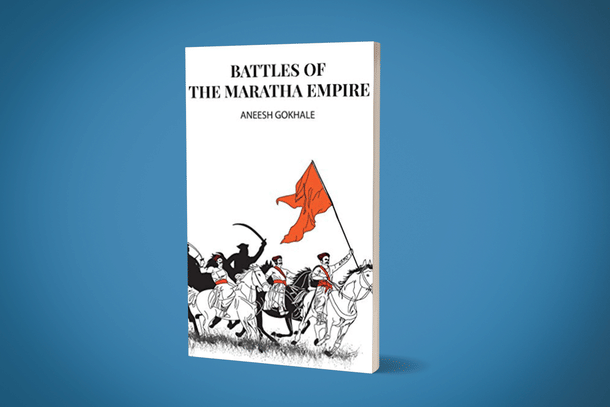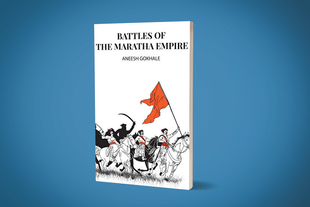Books
Maratha History And Decline Of Mughal Power Told Through The Battles They Won Or Lost
R Jagannathan
Jun 18, 2021, 07:55 PM | Updated 07:55 PM IST
Save & read from anywhere!
Bookmark stories for easy access on any device or the Swarajya app.


Battles of the Maratha Empire. Aneesh Gokhale. Dnyanganga Prakashan, Pune. Pages 283. Price Rs 400.
India can never tire of reading about the exploits of Chhatrapati Shivaji Maharaj, the man who tormented the Mughal empire under Aurangzeb despite starting out as a vassal and jagirdar of Bijapur’s Ali Adil Shah.
Among the better books are Jadunath Sarkar’s Shivaji & His Times, published almost exactly a century ago in 1920, Babasaheb Purandare’s Raja Shiv Chhatrapati (in Marathi), Gajanan Mehendale’s Shivaji: His Life and Times, Ranjit Desai’s Shivaji: The Great Maratha (translated by Vikrant Pande), and James Laine’s controversial Shivaji: Hindu King in Islamic India, among others.
Shivaji evokes great interest not only because he was one of the first to talk of Hindavi Swarajya, but specially because his military tactics were extraordinarily innovative and built around sound knowledge of how forts can be central to command and control of territory in victory and defeat. His fast-and-swift movements against enemies with larger forces are required reading for even modern-day generals who need to capture territory and hold ground.
So, what can a new book on Shivaji and the Maratha empire he started to create tells us? Aneesh Gokhale, a merchant marine officer, in a slim volume titled Battles of The Maratha Empire, brings into sharp focus all the battles won and lost by the Marathas, starting with Shivaji, continuing with the eminently successful Peshwas, and ending with the fall of the Maratha empire between the loss and Panipat in 1761 and evisceration at the hands of the British in 1818.
Maratha power reached its zenith under the Pune-based Peshwas, with Bajirao 1 (1700-1740) being it leading light. As Gokhale underlines, it was not the Mughal Empire that gave way to British rule, but the Marathas. The Marathas had cut the Mughal empire down to size, with the emperor in Delhi merely being the man holding the big title, but relatively subservient to the Marathas.
The moot question, which Gokhale tries to answer in the end, is this simple one: why did the Marathas not replace the Mughal emperor in Delhi despite their military superiority?
Gokhale believes that the Marathas decided not to go the whole hog for many reasons, and these include the difficulty in completely replacing the Afghan-Turkish ecosystems that the Mughals had created, and the possibility of facing a religious revolt by Muslims, etc. This raises the question about whether the Marathas also finally fell prey to the all-too-familiar disease of appeasement politics at the height of their power. We can’t be sure this wasn’t the case.
The power of Gokhale’s book lies not in its brilliant writing, for the book could have been much better written and thoroughly proof-read, but in the way it discusses each major battle of the Marathas during the 1659-1818 period when they rose to national prominence and then declined.
Each battle mentions the key people who played a role in it, the tactics adopted by the Marathas (both the successful ones and the failed ones), and the final outcome with special reference to how it might have impacted the history of both the Marathas and India. This came easily to Gokhale, for large parts of the book were written as single articles on specific battles written for various publications, including Swarajya.
The book, correctly, starts with Shivaji’s acute understanding of the science of hill forts, which is the key to the Chhatrapati’s early successes. The Marathas built and took over impregnable forts in the Sahyadris, some by fighting and others by guile, but their distinctive contribution was in how each fort was stocked with large quantities of water and grain.
Each fort had multiple entry and exit points, making successful sieges difficult, and equally important, forts were paired, which enabled one that was under siege to help the other, or allow the soldiers to escape from one to the other in case of impending defeat.
Above all, the Maratha successes were underpinned by superb intelligence gathering mechanisms, which ensured that small groups of motivated soldiers could withstand the might of much larger armies.
Equally important was the administrative structure which Shivaji created by abolishing the traditional rights of feudal watandars and making them partners in the wider vision of Swarajya for the nascent nation. This not only prevented needless infighting and rebellion, but created the right conditions for a unified and highly motivated fighting force.
Subterfuge was another important element in Shivaji’s rise to prominence, and no mention of his exploits can be complete without his carefully orchestrated killing of Afzal Khan, Adil Shah’s most important general.
Shivaji lured Afzal Khan by sending out spurious information that he was mortally scared of him, and met him at a place where Shivaji’s trusted lieutenants, Moropant Pingale and Netaji Palkar, were ready to defeat the Bijapur army. It was after this that Shivaji loomed larger as a threat to both the Adilshahi in Bijapur and the Mughal emperor in Delhi.
But the bigger Maratha-Mughal battles began only after Shivaji’s passing in 1680, and his successor Sambhaji faced the full might of Aurangzeb, who vanquished the two Deccan sultanates, the Adilshahi of Bijapur and the Qutubshahi of Golconda, in barely two years. But Sambhaji resisted for longer, and it was only his capture by Aurangzeb’s forces in 1689 that ended in tragedy. He was beheaded and his head was put on display in various towns of Maharashtra, but this is where the Marathas showed their true mettle.
Far from being demoralised by the humiliation of their fallen leader, the Marathas and others smaller social groups opposed to the Mughal emperor fought on and continued the war. Despite suffering losses many a time, they held on till Aurangzeb’s death in 1707 marking the beginning of the end of the Mughal empire.
Gokhale lists 69 battles fought by the Marathas under Sambhaji, 15 against the Portuguese, and four against the Siddis of Janjira. After the death of Aurangzeb, Sambhaji’s son Shahu, who was held captive in Delhi for nearly 14 years, was released and became Chhatrapati who ruled from Satara. His uncle Rajaram ruled another Maratha kingdom from Kolhapur.
It was under Chhatrapati Shahu, and his Peshwa Balaji Vishwanath Bhat (1662-1720) and his descendants, that Maratha power started rivalling the Mughals nationally. In particular, Balaji Vishwanath’s talented and ambitious son, Bajirao I, made it clear that Maratha ambitions would not remain confined to the south of the Vindhyas. They would seek to plant the flag of Swarajya all the way to Attock on the banks of the Indus.
It is not my intention here to summarise the rest of Maratha history till their final significant defeat at the third battle of Panipat, where Vishwasrao, grandson of Bajirao I, lost to Afghan Ahmed Shah Abdali due to poor tactics and the Peshwa’s failure to secure Bundelkhand – which lay at the strategic crossroads of north Indian history, when it was possible to do so.
Maratha power lasted as long as they sought to remain on the offensive, constantly innovating in battle, and recovering from every setback. Once they started thinking more defensively, they began to lose. They finally lost to the firepower and strategy of the East India Company in 1818.
But it is worth mentioning that the Marathas were more than just about Swarajya, for what is Swarajya without a cultural component? Under the Holkars, especially Devi Ahilyabai Holkar, who ruled from 1766 to 1795 after the death of her father-in-law Malharrao Holkar, the Marathas were instrumental in rebuilding temples, constructing pilgrimage centres and temple ponds all over India. Ahilyabai’s husband Khanderao Hokar had died in battle, and it was Ahilyabai who succeeded her father-in-law. She also personally led her army into battles.
Gokhale lists at least 30 temples to which she made contributions, apart from 34 dharamshalas, temples and ghats, including the temple that was demolished by Aurangzeb in a fit of bigotry at Varanasi.
The point to note is that all this happened after the Marathas lost politically with their defeat at Panipat in 1761. Long after political power waned, the Maratha contribution to India’s cultural rebirth continued for some more time.
The book shows how political and cultural power are inter-linked. One cannot endure without the other. This is a lesson for India’s modern-day Hindu cultural revivalists.
(The above version corrects the earlier one which wrongly mentioned Ahilyabai as the wife of Malharrao Holkar. He was her father-in-law)
Jagannathan is former Editorial Director, Swarajya. He tweets at @TheJaggi.





